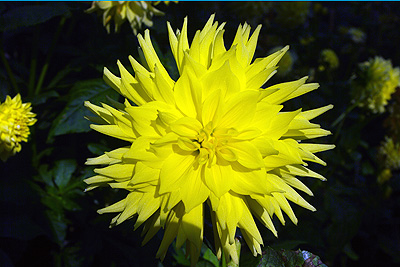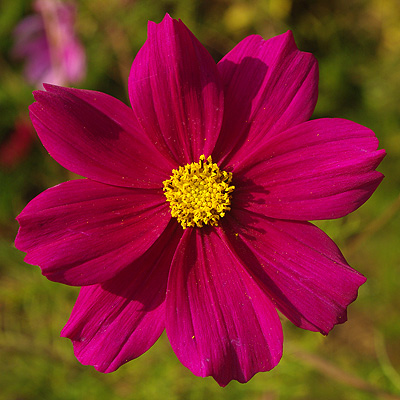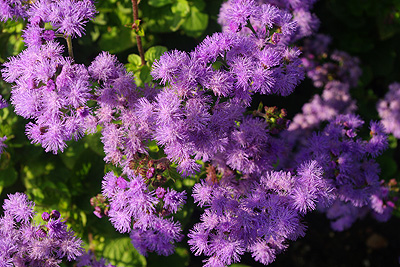The Garden in October - Jobs and Tips
plants for October
Jobs / Tips
![]() Plant spring flowering bulbs for next year if you
haven't yet done so. There's nothing quite like some luxurious
bowls of large hyacinths that you've planted yourself flowering
in in the depths of winter. buy:
crocus,
daffodils and narcissi,
hyacinths,
tulips
Plant spring flowering bulbs for next year if you
haven't yet done so. There's nothing quite like some luxurious
bowls of large hyacinths that you've planted yourself flowering
in in the depths of winter. buy:
crocus,
daffodils and narcissi,
hyacinths,
tulips
![]() Apply an
Autumn fertiliser
to lawns - this is different to a spring fertiliser, so
make sure you don't get them mixed up. Spring fertilisers have
high nitrogen to get the leaves growing strongly, something
you don't want now. An autumn fertiliser has high phosphorous
and potassium to build up a strong root system that help get
the grass plants through the winter and arrive at next spring
in good shape for the new growing season.
Apply an
Autumn fertiliser
to lawns - this is different to a spring fertiliser, so
make sure you don't get them mixed up. Spring fertilisers have
high nitrogen to get the leaves growing strongly, something
you don't want now. An autumn fertiliser has high phosphorous
and potassium to build up a strong root system that help get
the grass plants through the winter and arrive at next spring
in good shape for the new growing season.
![]() The best time of year to make a new lawn or repair
an existing one. Lay turf or scatter
grass seed
to repair damaged areas. Don't just throw the seed down and
hope for the best. Get a rake and give the ground it a good
stiff going over to break up the surface and get a layer of
crumbly soil (this is hard work) scatter the grass seed and
then rake again to bury most of the seed under the crumbly stuff
you've just made. Water it well and don't walk on it for ages
- until the first mowing in fact, which shouldn't be until the
grass is about 2 inches tall.
The best time of year to make a new lawn or repair
an existing one. Lay turf or scatter
grass seed
to repair damaged areas. Don't just throw the seed down and
hope for the best. Get a rake and give the ground it a good
stiff going over to break up the surface and get a layer of
crumbly soil (this is hard work) scatter the grass seed and
then rake again to bury most of the seed under the crumbly stuff
you've just made. Water it well and don't walk on it for ages
- until the first mowing in fact, which shouldn't be until the
grass is about 2 inches tall.
![]() Last chance to trim deciduous hedges - If you
haven't done this by the end of the month, it's best left until
the spring when they're growing again.
Last chance to trim deciduous hedges - If you
haven't done this by the end of the month, it's best left until
the spring when they're growing again.
![]() Place a net over your garden pond if you have one and if
the are trees nearby, or at least check it on a regular
basis and don't let fallen leaves sink to the bottom. They build
up in surprising quantity, rob the pond of oxygen as they rot
and introduce an abundance of nutrients that can encourage excessive
algal growth next year.
Place a net over your garden pond if you have one and if
the are trees nearby, or at least check it on a regular
basis and don't let fallen leaves sink to the bottom. They build
up in surprising quantity, rob the pond of oxygen as they rot
and introduce an abundance of nutrients that can encourage excessive
algal growth next year.
![]() Take hardwood cuttings of deciduous shrubs. They won't
be rooted until well into next year so put them somewhere that
they will not be disturbed.
Take hardwood cuttings of deciduous shrubs. They won't
be rooted until well into next year so put them somewhere that
they will not be disturbed.
![]() Plant any shrubs, perennials, trees etc. that you had planned
to. This is an excellent time for planting and the best
time of year. It gives the plants a chance to get a decent root
system before they become dormant, it also protects the roots
from the worst of frost being below the ground rather than in
a container. Come next spring, the plants are there from the
earliest time to make growth directly into the surrounding soil.
Plant any shrubs, perennials, trees etc. that you had planned
to. This is an excellent time for planting and the best
time of year. It gives the plants a chance to get a decent root
system before they become dormant, it also protects the roots
from the worst of frost being below the ground rather than in
a container. Come next spring, the plants are there from the
earliest time to make growth directly into the surrounding soil.

![]() Continue to dead-head summer bedding plants. They are still
producing new flowers, less than in the summer, but they last
longer in the cooler temperatures, so they can still look as
good as they did in high summer. Dead-head, not so much to keep
them flowering, but to stop the faded flowers holding the damp
and encouraging grey mould which will take over and kill them
all the quicker. Frosts permitting, you should be able to get
nearly another month from the summer bedding plants.
Continue to dead-head summer bedding plants. They are still
producing new flowers, less than in the summer, but they last
longer in the cooler temperatures, so they can still look as
good as they did in high summer. Dead-head, not so much to keep
them flowering, but to stop the faded flowers holding the damp
and encouraging grey mould which will take over and kill them
all the quicker. Frosts permitting, you should be able to get
nearly another month from the summer bedding plants.
![]() Autumn is the time for a garden tidy-up. It's
not just an aesthetic job, sweeping up leaves, cutting back
dead flowers, and branches removes places that pests can over-winter
and also gives fungal spores less places to hide and food to
eat. Don't be too enthusiastic about cutting everything back,
tall dried seed heads from plants such as grasses add distinctive
elegance to the winter garden, particularly when picked out
by the low-lying sun or highlighted by frost.
Autumn is the time for a garden tidy-up. It's
not just an aesthetic job, sweeping up leaves, cutting back
dead flowers, and branches removes places that pests can over-winter
and also gives fungal spores less places to hide and food to
eat. Don't be too enthusiastic about cutting everything back,
tall dried seed heads from plants such as grasses add distinctive
elegance to the winter garden, particularly when picked out
by the low-lying sun or highlighted by frost.
![]() Don't compost leaves or branches from diseased plants
- these should be removed from the garden or burnt on a bonfire.
Larger branches and sections of tree trunks can be stacked up
in a quiet corner of the garden to form a slowly decaying log-pile
which will provide a home and food for all manner of beneficial
insects.
Don't compost leaves or branches from diseased plants
- these should be removed from the garden or burnt on a bonfire.
Larger branches and sections of tree trunks can be stacked up
in a quiet corner of the garden to form a slowly decaying log-pile
which will provide a home and food for all manner of beneficial
insects.
![]() Saving half hardy bedding plants. Many summer bedding plants
are actually perennials and can easily be saved from one year
to the next. I have the most success with Geraniums (Pelargoniums)
and Fuchsias. Bring them under shelter before the frosts. Cut
the stems down by about 2/3rds of their length (don't worry
if this means you have virtually no leaf, they should grow again.
Strip off dead or dying leaves and flower heads. Anything that
can rot over the winter will rot and may spread to the living
plant.
Saving half hardy bedding plants. Many summer bedding plants
are actually perennials and can easily be saved from one year
to the next. I have the most success with Geraniums (Pelargoniums)
and Fuchsias. Bring them under shelter before the frosts. Cut
the stems down by about 2/3rds of their length (don't worry
if this means you have virtually no leaf, they should grow again.
Strip off dead or dying leaves and flower heads. Anything that
can rot over the winter will rot and may spread to the living
plant.
They need to be in a sheltered but cool place free of frost. An greenhouse is ideal as long as you can heat it gently during the coldest periods to stop it frosting inside, a small paraffin heater will do this effectively. Leave the plants in their summer containers and lift them off the ground on shelves or on bricks to just raise them above the coldest temperatures (heat rises, cold falls). Water sparingly, they are best kept dry as far as possible as long as the leaves don't wilt. The idea is to keep them dormant rather than actively growing.
Copyright 2000 - present. All Rights Reserved | Privacy Policy Statement




